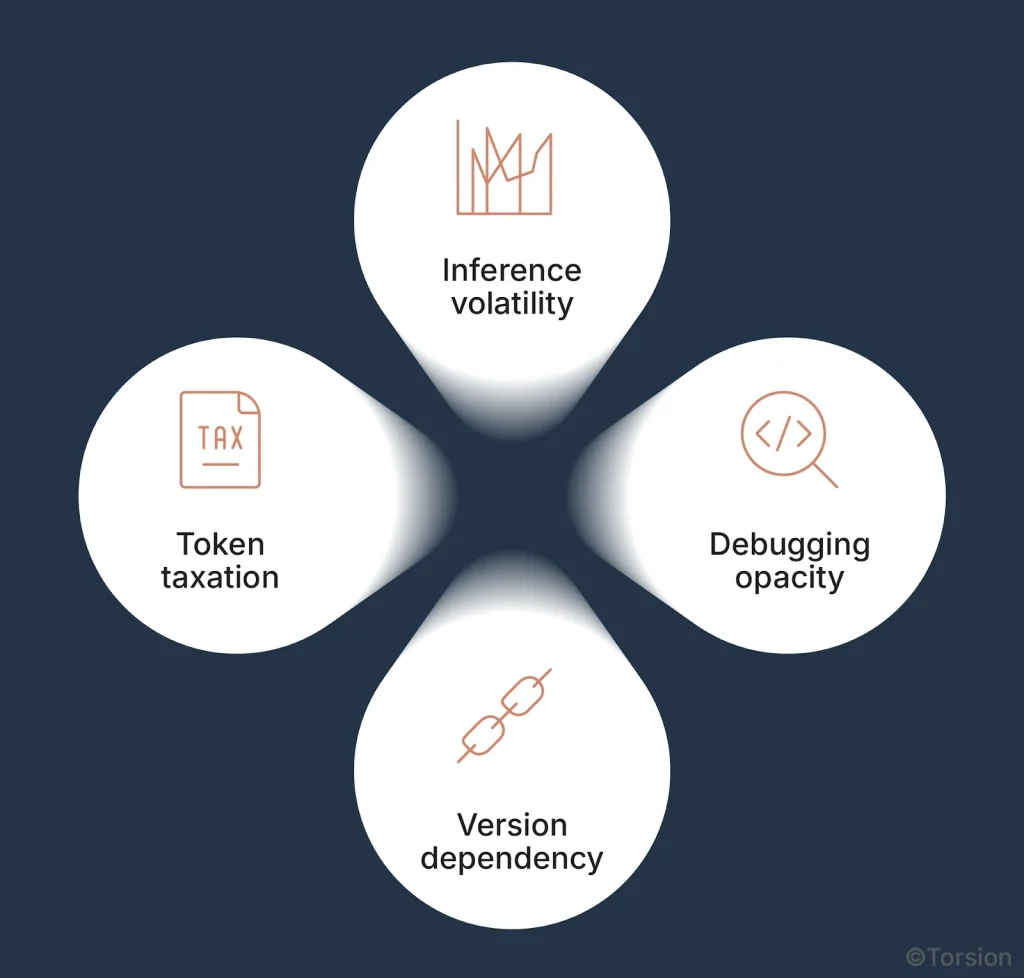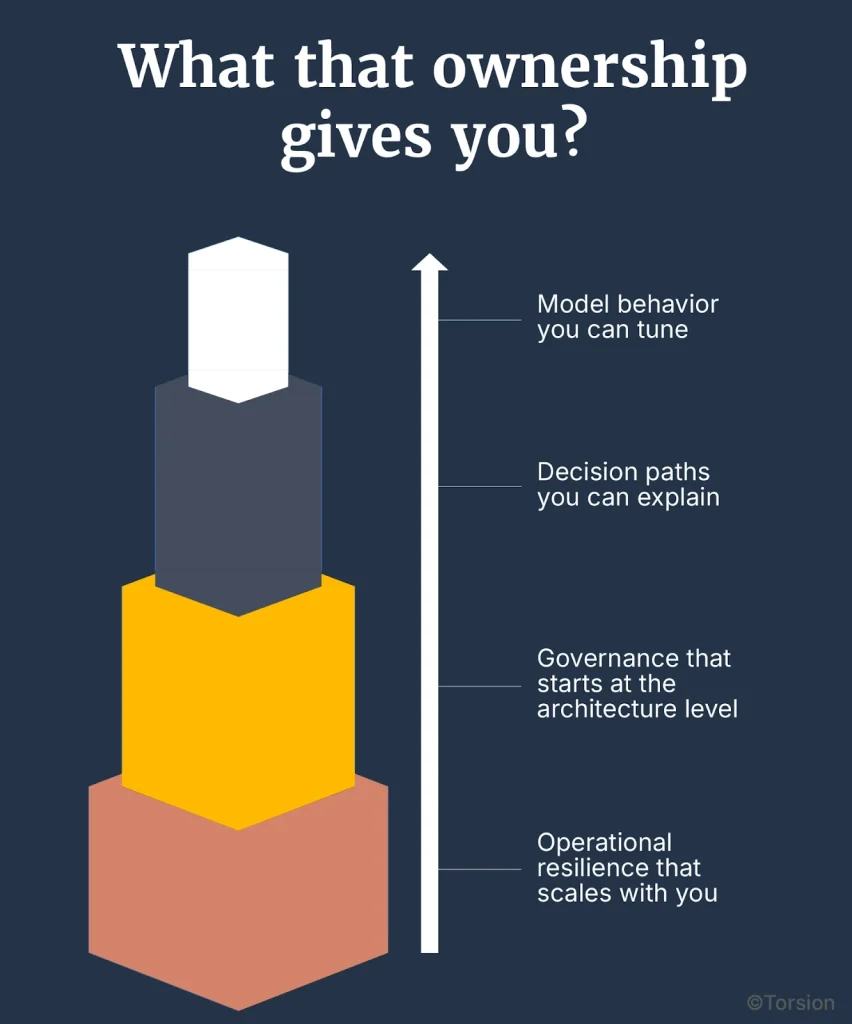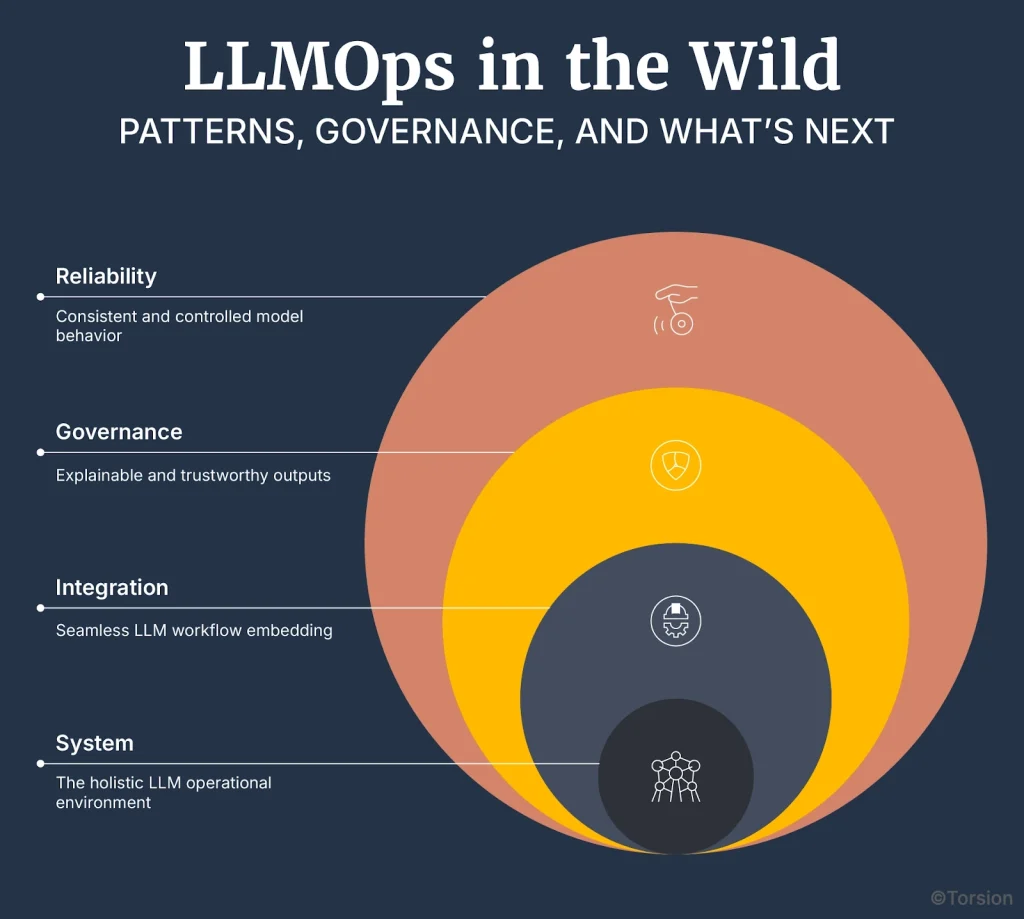Key Takeaways
- Proprietary APIs create hidden risks in healthcare workflows
- Open-source LLMs now match proprietary performance in key tasks
- Full LLM ownership enables governance, auditability, and tuning
- Payer orgs should migrate in phases, starting with low-risk use cases
- Production LLMOps requires fallback logic, version tracking, and real-time oversight
- The next frontier is behavioral control for better models
A mid-sized payer is knee-deep in implementation. Their LLM handles denial letters, benefit explanations, and call summaries. It’s fast. Mostly accurate. But when the model starts generating inconsistent language around coverage policies, there’s a problem.
They escalate to the vendor and receive only radio silence in return. Then an update rolls out. It fixes the issue, but breaks something else.
No changelog. No rollback. No visibility into what actually changed.
This is the deal you make when you don’t own your infrastructure.
For years, proprietary LLM APIs seemed like the smart choice. Quick setup. Great demos. Impressive output.
But now, payers are realizing what they gave up in exchange: control, flexibility, and the ability to explain what their systems are doing.
That trade-off doesn’t hold anymore. Open-source LLMs are outperforming, and more importantly, they’re trainable, inspectable, and auditable.
This blog is about that shift. The one where healthcare payers move from renting language to owning logic. From reacting to roadmap changes to setting their own. From black-box dependency to full-stack independence.
The reset has started. And the early movers are already pulling away.
The Hidden Cost of Dependence
Proprietary LLM APIs may offer convenience, but for payers, they introduce operational risk. Inference volatility, debugging opacity, and forced version upgrades disrupt workflows and reduce control. Without model transparency or explainability, organizations cannot ensure compliance or trust. In healthcare, where outputs drive decisions, LLMs must be governable infrastructure, instead of opaque external tools.
Relying on closed LLMs for benefit explanations or denial logic exposes payer orgs to instability and risk. Vendor changes can break workflows, obscure errors, and leave teams unable to trace or correct model behavior. True Enterprise AI in healthcare requires visibility, traceability, and control. Anything less is exposure.
OpenAI doesn’t know your claims logic. Anthropic doesn’t know your CMS audit requirements. Yet, many payer orgs still rely on these providers to generate language that explains benefits, denials, and policy nuances. That gap between model behavior and organizational control? It’s where risk lives.
In theory, proprietary LLM APIs make life easier. No infrastructure, retraining, or DevOps. But inside payer systems, ease of access doesn’t mean ease of integration. What looks like efficiency on day one turns into hidden debt by day ninety.

Here’s how it shows up:
- Inference volatility. Vendor updates shift model behavior without warning. Yesterday’s compliant output becomes today’s red flag and you can’t even diff the change.
- Token taxation. You pay for every word, but have no say in how the model allocates context across prompts, summaries, or clarifications.
- Debugging opacity. When something breaks, you’re left guessing. No access to internal logs. No model visibility. No way to explain what happened especially when the output was technically fluent, but semantically wrong.
- Version dependency. New model release? Great, except it breaks prompt chains that power live workflows. Now you’re scrambling to retrofit everything or risk service downtime.
And this doesn’t even touch on security posture, HIPAA boundary enforcement, or explainability under audit. In payer orgs, where language drives clinical and financial decisions, “we can’t see what it did” isn’t an acceptable answer.
If your model is embedded in member comms, prior auth workflows, or claims routing, it is no longer an external tool. It’s part of your critical infrastructure. And critical infrastructure needs to be governable, inspectable, and explainable.
Without that, you’re not operationalizing LLMs. You’re outsourcing trust.
Performance Parity Is Here, and Payers Are Quietly Taking Advantage
Open-source LLMs now match or outperform proprietary models in payer workflows like denials, prior auth, and multilingual support. Models like DeepSeek-V3 and LLaMA 3.2 deliver higher accuracy and lower cost. Once performance is equal, control becomes the deciding factor. For payers, that means choosing models they can fine-tune, inspect, and explain under audit.
The performance gap is gone. Payers are quietly switching to open-source LLMs like DeepSeek and Mixtral that beat closed models on domain-specific tasks. These models are easier to tune, cheaper to run, and fully auditable. In healthcare, where regulation meets real-world complexity, the model you can govern is the one that scales.
The defense of proprietary LLMs used to be simple. Yes, they were expensive. Yes, they were black boxes. But they worked better.
That’s no longer true.
Open-source LLMs have closed the gap and in many payer-specific use cases, they’ve pulled ahead. Not on general benchmarks, but on tasks that matter: reasoning over plan language, clarifying denials, translating policy into member-facing responses.
These are internal benchmarks with real case data and live audits.
- DeepSeek-V3 outperforms GPT-4 in multi-step denial analysis. It’s faster, more precise, and less prone to hallucinations.
- LLaMA 3.2 delivers near-GPT-4 output quality in prior auth explanations, but at a fraction of the cost.
- Mixtral 8x7B excels in multilingual claim handling, especially where Spanish-English transitions are common. Its outputs are cleaner, more consistent, and easier to verify.
- Gemma-2 offers fine-tuning agility that’s proving essential for teams reacting to CMS updates or internal policy shifts.
Once parity is reached, the decision logic shifts. You’re no longer asking, “Is this good enough?” You’re asking, “Why are we paying more for a model we can’t control or inspect?”
That’s the moment where open-source becomes not just viable, but preferable.
In healthcare, the model that performs is table stakes. The one you can govern is the one that wins. And more payer teams are figuring that out quickly.
Why Ownership Becomes the Next Strategic Advantage
When LLMs shape coverage language and denial explanations, payers must own the logic behind the output. Ownership delivers prompt-level traceability, audit-ready decision paths, and infrastructure aligned with regulatory expectations. It ensures the system behaves as intended, not as dictated by a vendor update. In high-stakes communication, control is not optional. It is infrastructure.
LLM ownership shifts payers from reactive consumers to strategic operators. With full control over model tuning, logging, and deployment, organizations can align output to internal policy and regulatory demands. Proprietary APIs offer output without visibility. Open models offer infrastructure you can explain, govern, and evolve. In healthcare, that distinction defines operational readiness.
Once open models match proprietary ones in performance, the logic shifts. The question is no longer whether they work. The question is whether you can afford not to own them.
For healthcare payers, the answer is usually no.
These models are not writing blogs. They are shaping communications with members, providers, and regulators. They generate language that reflects your benefits, your policies, and your risk exposure. That means they are infrastructure. And infrastructure must be owned.
What that ownership gives you?
1. Model behavior you can tune
Your data, prompts, and logic. You train it to match your policy language and audit thresholds. You do not wait for a roadmap or send a feature request.
2. Decision paths you can explain
Every output is linked to a prompt version, a model checkpoint, and an internal rule. When compliance or legal asks why something was said, you can show them exactly how it was generated.
3. Governance that starts at the architecture level
Access control, audit logs, and retention policies are not bolted on. They are built into the system from the start, aligned to HIPAA, CMS, and internal audit frameworks.
4. Operational resilience that scales with you
You are not subject to sudden API pricing shifts or deprecation notices. The models evolve on your timeline, while your infrastructure stays stable, even when vendors change direction.
This helps in reducing cost and increases leverage.

Because in healthcare, LLMs are not assistants. They are decision partners. If they cannot be governed, they cannot be trusted. And if you do not own them, you cannot govern them.
This is where payer strategy is going next.
From Dependency to Autonomy: How Payers Transition Without Risk
Payers should prioritize migrating internal systems like claims summarization, denial drafting, and policy QA where model behavior must be traceable and explainable. Version rollback, prompt lineage, and role-based access ensure outputs can be audited and governed. Proprietary APIs may remain for latency-critical tasks, but the core inference stack should be owned and controlled.
The shift from API dependence to infrastructure control starts by moving use cases that demand behavioral fidelity over speed. Workflows like benefit interpretation and internal reviews benefit from token-aware routing, model versioning, and audit-ready governance. Inference becomes part of your infrastructure once it’s traceable, secure, and internally managed.
Owning the model is the goal, but getting there requires discipline.
Payer systems don’t allow for sloppy transitions. The regulatory surface is too wide and the operational load is too real. But this is where the leaders separate from the rest.
They don’t wait for vendor roadmaps or react to token spikes.Moving early and carefully, leaders focus on controlled inference, structured feedback, and observable behavior before shifting to high-risk automation.
It’s not a rip-and-replace moment. Rather a staged migration.
Here’s what that transition actually looks like inside mature payer orgs.
Phase 1: Start where structure is strong and compliance risk is low
- Deploy open models in workflows like wellness nudges, onboarding prompts, or benefit education in areas where tone matters but legal exposure is limited
- Host in a secure containerized environment, with prompt logging and token telemetry enabled from day one
- Measure output variability across different member segments, especially under prompt revision
- Track hallucination patterns, tone shifts, and cost per interaction—don’t just score accuracy, observe behavior
- Use this phase to train your team on prompt governance, not just prompt engineering
With this you gain operational fluency without jeopardizing member trust or compliance posture.
Phase 2: Run parallel inference inside live systems
- Mirror real inputs like prior auth decisions, EOB summaries, and member inquiries through both proprietary and open-source models
- Compare outputs across hallucination rate, tone calibration, context retention, and latency under concurrent load
- Inject real constraints: token caps, prompt complexity variation, multilingual edge cases
- Layer in scoring from compliance, legal, and operations observe how your reviewers interact with and critique the model
- Log every input-output pair with semantic diffing, and track failure recovery routes
Phase 3: Migrate workloads where traceability matters more than speed
- Start with systems that shape internal decisions, not just surface-level responses
Think claim summarization flows, plan document QA, or draft builders for denials and appeals - Prioritize use cases that need behavior you can control—not millisecond response time
These aren’t high-frequency calls, but they carry weight in audits, reviews, and compliance workflows - Build infrastructure to support version rollback tied to policy changes or audit triggers
If a prompt or model variant drifts after a CMS update, you need to trace and revert immediately - Implement prompt lineage tracking and token-aware routing
Your routing logic should be informed by intent, complexity, and sensitivity—not just user role - Add access controls for prompt editing and model output handling
Who can edit? Who can deploy changes? Who can approve drift? That has to be enforceable in production - Keep proprietary APIs in place only where they’re contractually locked or latency-sensitive
Everything else should move to systems your team can govern, explain, and evolve
LLMOps in the Wild: Patterns, Governance, and What’s Next
In production, LLMs need behavioral control, explainability, and integration before accuracy. Payers must implement guardrails, prompt-level traceability, and fallback systems to govern output. Real-time auditing, model provenance, and API orchestration enable safe, compliant deployment. The next frontier in Enterprise AI is not model performance, but system-level LLMOps maturity.
As LLMs move into critical payer workflows, governance and reliability become non-negotiable. Circuit breakers, prompt versioning, human-in-the-loop review, and modular orchestration define production-ready LLMOps. Leading organizations are already experimenting with autonomous tuning and multi-agent collaboration. The future of Enterprise AI will be won by those who operationalize intelligence, not just deploy it.
By this stage, the stack is yours. But owning infrastructure isn’t enough. You need systems that behave predictably, traceably, and under pressure.
This is where most deployments fail. Not because the model can’t generate. Because no one knows what to do when it does something unexpected.
Here’s what real LLMOps looks like in the wild.

#Reliability: Not just model uptime, but behavioral control
The model won’t fail often. But when it does, it better fail safely.
- Trigger circuit breakers based on hallucination detection, low-confidence scores, or tone deviation
- Use fallback logic tied to business rules, not just generic error handling
- Validate new models in shadow mode—test for semantic shifts, not just token outputs
- Escalate to human review based on uncertainty thresholds or regulatory keywords
- Log not just failure, but how the system handled it
#Governance: If you can’t explain the output, you can’t trust it
Explainability must be engineered into every layer. Because in healthcare, if your system can’t show how it made a decision, that decision is a liability.
- Log all prompts with version IDs, user context, and response lineage
- Enable real-time tracing from input to output—who said what, when, and under what model version
- Monitor fairness across coverage tier, plan type, geography, and member profile
- Track model drift not by token difference, but semantic deviation
- Provide explainability layers for reviewers, compliance, and auditors—human-readable, audit-ready
#Integration: Embed LLMs into your workflows
LLMs can’t sit off to the side. They need to live inside your workflows.
- Route member queries using API gateways that triage by intent, language, or risk level
- Use event-driven triggers for new claims submitted, appeals escalated, or docs uploaded to update LLM context
- Modularize services: one for eligibility, another for benefit summary, another for escalation logic
- Wrap legacy systems with adapters to expose necessary logic to inference. Don’t rewrite, just integrate
#What’s Next: The Edge is Shifting from Model to System
Advanced orgs are already testing what’s coming.
- Self-optimizing inference: prompt adaptation and routing based on outcome data
- Multi-agent orchestration: claim bots, appeal bots, QA validators passing control mid-session
- Semantic drift detection in real time—before errors become incidents
- Quantum-classical co-processing for inference optimization (early, but real)
Lead the Transformation or Follow in Others’ Wake
The performance gap is closed. The control gap is widening. And for payers, you’ve to be ready and your open-source LLMs must be ready as well.
Those who move first are cutting costs and rethinking how their systems explain, adapt, and govern themselves. They’re training models that reflect their policy logic while building infrastructure that doesn’t wait for a roadmap to evolve.
This is more a leadership one, rather than a technology one.
Because the organizations that own their Enterprise LLM stack will own their workflows, their risk profile, and ultimately, their market position.
The rest? They’ll follow the terms someone else wrote and hope the system still speaks their language.





